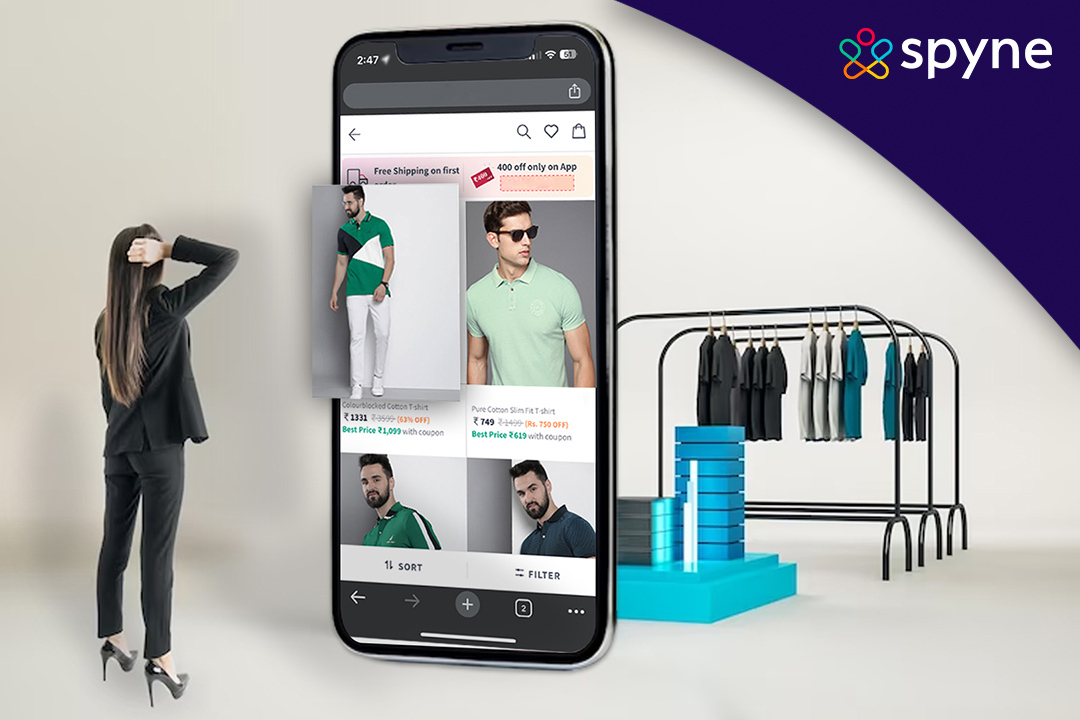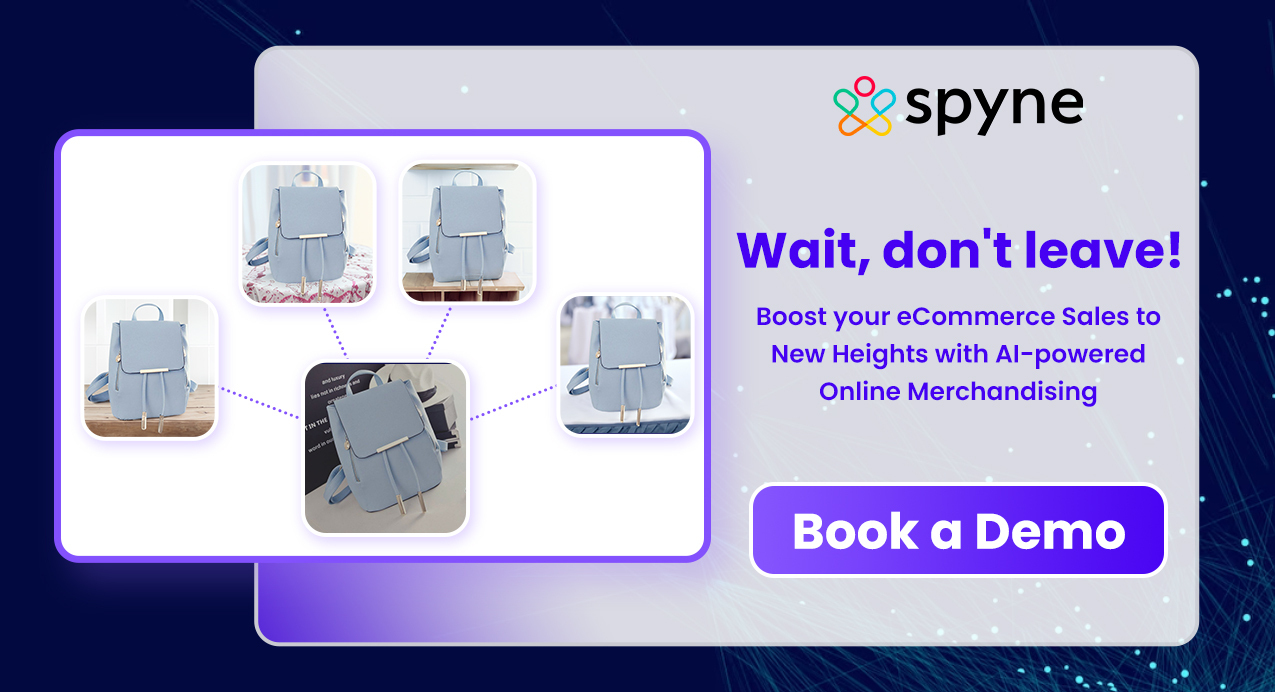Have you ever wondered why a display merchandiser sets mannequins in stores and has the best outfits? Or why bright, classy clothes are near the entrance while the rest are neatly folded? It’s because how products are arranged, and the staff’s assistance determine how long you will browse. The same goes for websites and apps. People dislike scattered products on home and category pages. They are okay with alternative suggestions for a better experience. So, that is where visual merchandising in retail comes into play.
This blog covers everything about visual marketing for eCommerce: what it is, why it’s essential, and best practices. Let’s dive in!
What is Visual Merchandising?
Merchandising displays are all about captivating shoppers with compelling visuals to entice them to browse, explore, and make purchases. A visual merchandiser helps promote a brand’s image and its products involves online merchandising strategy, product photography setup, planning, and designing an immersive shopping experience, focusing on the big picture and minor visual elements. It is a marketing practice that utilizes floor plans, color, lighting, displays, technology, and other elements to attract customer attention. Visual listing in retail extends to your website’s overall use of space and color schemes. By mastering the art of e-commerce visuals listing, you can create a captivating and seamless online shopping journey for your customers.
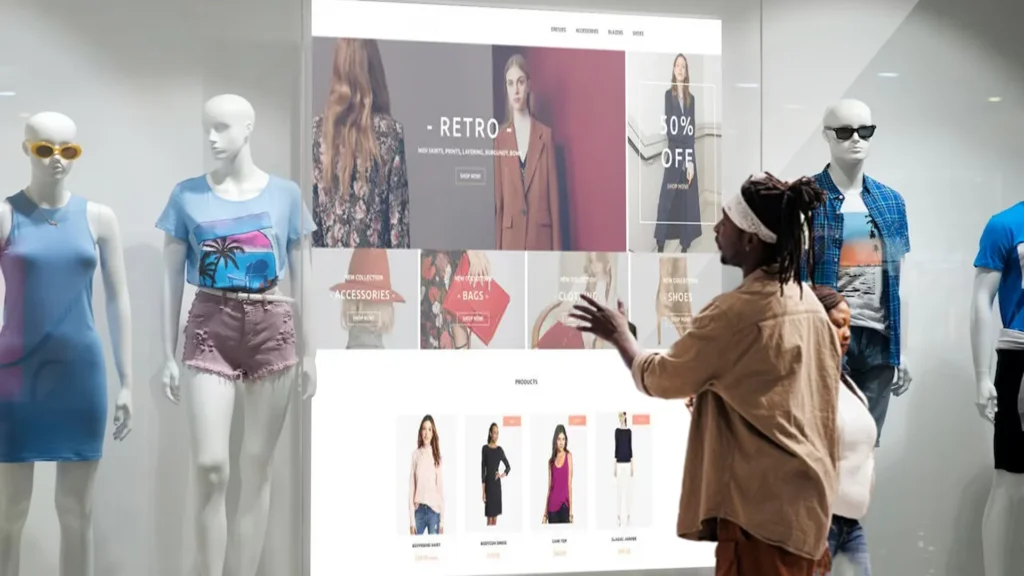
Therefore, Merchandising using visuals can greatly improve overall retail and bring new customers to the shop. Though the strategy and execution can take time, the benefits are huge. Thus, some of the benefits are:
Benefits of visual merchandising
Brand consistency
Successful merchandising displays are a reflection of your brand’s essence. It stays true to your company’s overall image and values. Imagine a franchise business where all its franchisees showcase consistent promotional displays. This consistency creates a sense of identity and ensures brand coherence.
Increased customer engagement
A captivating and inviting store entices people to step inside and assists them in discovering the perfect product. Merchandising displays are crucial in crafting a delightful shopping experience that keeps customers returning for more.
Rise in conversions
Boost your sales with effective and creative visuals. By strategically guiding customers to the products they desire or require, you can witness a significant increase in sales. Moreover, merchandising aids in introducing customers to new products and innovative solutions.
Elements of display merchandising
Colors
Color holds immense power to influence sales in retail. It can make or break your visual listings displays, so retailers must carefully coordinate colors that captivate customers. Combining contrasting colors can be particularly effective in crafting attention-grabbing displays that leave a lasting impact.
Maximum display
When you highlight your products effectively, they offer customers a wide range of choices. Consider implementing a circular store layout instead of the traditional one. This layout exposes customers to a greater variety of merchandise than conventional aisles. To maximize your impact, have numerous merchandising displays and present as much inventory as possible. The more options you provide, the better the shopping experience for your customers.
Storytelling
Storytelling is a game-changer in marketing, and it holds great significance in merchandising as well. By crafting a compelling and sales-driven story, you can enhance your visual displays and effectively communicate the benefits of purchasing a specific product to your customers. This approach improves the overall visual appeal and enables a deeper understanding of your customers.
Empty Spaces
Visual in retail doesn’t just revolve around the displayed merchandise; it also taps into the often overlooked space between the products and the ceiling. This underutilized area holds immense potential, and savvy retailers know how to make the most of it. Use this space wisely by showcasing information about specific products or brands. You can even leverage it to display customer testimonials with the customer’s name and picture.
Focal point
Creating a focal point can have a significant impact on boosting sales. Display merchandiser needs to check their store displays to ensure that hotspots and merchandise are easily visible to customers. You can draw attention and pique curiosity by strategically positioning and highlighting essential items.
What is E-Commerce Visual Merchandising?
In-store merchandising is all about using visual elements to enhance the overall shopping experience for customers. Maximizing the visual appeal of store displays to charm potential buyers and drive sales. The art lies in presenting products in ways that intrigue customers, resonate with their needs, and showcase the unique features of each item. It creates an immersive and engaging shopping experience where customers can explore, interact, and make informed purchase decisions.
E-commerce image merchandising is crucial for the digital world since customers can’t physically experience products. That’s why a successful display visual merchandiser prioritizes eCommerce merchandising. Successful online businesses prioritize eCommerce visual displays to create a user-friendly store, boost engagement, and drive sales. It enhances the online shopping experience, maximizing customer satisfaction and sales with compelling visuals.
Many web stores need to pay more attention to the importance of a comprehensive online merchandising strategy. A solid interface is just the beginning. To succeed, your website must integrate brand messaging, personalized experiences, inventory management, convenience, and user-friendliness across channels and devices.
Key Elements of Visual Merchandising for eCommerce
Product images
In the best visuals merchandising displays, images are essential. They enable customers to examine product details, instilling confidence in your merchandise closely. In fact, 67 percent of consumers consider image quality crucial for making selections and purchases. Make sure to upload high-quality photos that showcase products in full detail from different angles.
Customer testimonials
In the age of social-savvy shoppers, professional images alone won’t cut it. They seek reassurance from fellow customers that the product they’re eyeing is worth buying. That’s where user-generated content comes in. Adweek says 93 percent of customers find user-generated content helpful when making purchase decisions.
Aesthetics
The colors and layout of your website are more than just brand aesthetics. They are potent tools to evoke emotions in your customers, ranging from calmness and confidence to happiness and excitement. When choosing colors, consider the specific feelings you want to produce, your target market, and the industry’s commonly used colors by competitors.
Mobile layout
Do you know that more than 51 percent of users prefer mobile eCommerce web apps to other shopping channels.? While many brands and retailers have mobile-responsive sites, display merchandising requires more than adjusting the screen size. Considering the space allocation for product images, UGC, navigation, and product collections is crucial.
Ranking strategies
Successful display merchandising aims to personalize the online shopping experience. Using smart merchandising rules and ranking strategies, you can prioritize product display based on availability, discounts, sales performance, ratings, and seasonality. This customization enhances relevance and appeal, boosting conversions and customer satisfaction.
Personalization
Thanks to new technologies, brands and retailers can now personalize their merchandising strategy for each shopper. This means promoting items, UGC, layout changes, and more that are most likely to appeal to individual customers. The future of impactful merchandising lies in the ability to understand and cater to the unique preferences of every visitor on your site.
What are the Objectives of Visual Merchandising Solutions?
The primary objective of merchandising visuals is clear-cut and important to attract shoppers and boost sales. A successful strategy seeks to pull customers into the store, retaining their attention sufficiently to make a purchase. It revolves around creating an immersive and pleasing shopping environment that not only attracts but persuades customers to make informed buying decisions.
By strategically placing products, utilizing attractive displays, and fostering a cohesive brand identity, merchandising aims to enhance the overall customer experience and increase foot traffic and, ultimately, higher sales conversions. The art of merchandising lies in its ability to seamlessly blend creativity with commercial appeal.
Why is Online Visual Merchandising Important?
Strengthen brand identity
You’ve probably heard the saying, “A picture is worth a thousand words.” And it’s true! People are naturally visual learners. Our brains process visuals a whopping 60,000 times faster than text. Conveying through compelling images, videos, and colors is a prime element to make a long-lasting impression with your brand message. For instance, if you want consumers to associate your brand with sustainability, using earthy colors and showcasing your efforts to lower your carbon footprint will make it easier and quicker for them to make that connection.
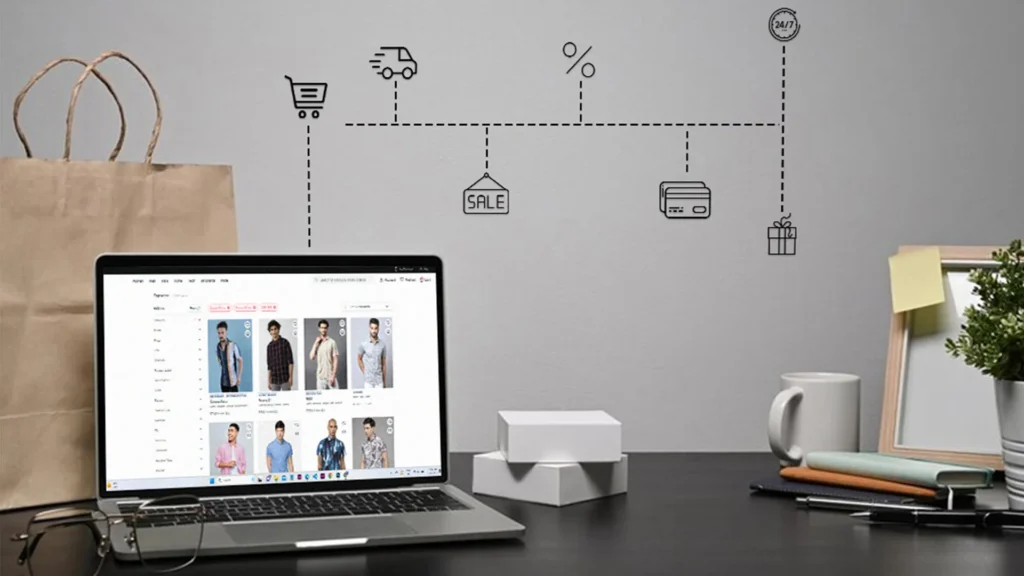
Research indicates that 75 percent of consumers assess a website’s credibility based on its visual design. With such a significant percentage, an appealing design reduces your bounce rate.
Initiating effective purchase decision
Did you know that more than 92 percent of consumers consider the visual aspect the primary factor when purchasing? Additionally, regarding user-generated content, which holds significant sway over shoppers, 85 percent of consumers find it more influential when visuals are included. By prioritizing visually appealing content and showcasing the most relevant products, you can experience a remarkable boost in your conversion rates.
Enhanced user experience
Merchandising in retail offers the opportunity to deliver a personalized shopping experience, which is paramount considering that 71 percent of consumers express frustration with impersonal experiences. Display merchandisers can show each shopper’s desired products by leveraging customer data in their merchandising efforts and enhancing their overall experience, keeping users engaged.
Best Practices for eCommerce Visual Merchandising
In the ever-evolving landscape of eCommerce, mastering display merchandising is essential for captivating customers and driving sales. Here are some best practices to elevate your eCommerce display merchandising strategy:
1) Invest in Personalization
Tailor the online shopping experience by investing in personalization. Leverage data to understand customer preferences and behavior, delivering a more customized journey.
2) Product Recommendations
Enhance user engagement by providing relevant product recommendations. Utilize algorithms to suggest items based on browsing history, purchase patterns, and current trends.
3) Provide Visual Cues
Guide customers through the online store with visual cues. Use strategically placed images, banners, and icons to direct attention to featured products, promotions, or key sections.
4) Applying Filters
Simplify the search process by incorporating effective filtering options. Allow customers to narrow down choices based on categories, sizes, colors, and other relevant attributes.
5) Branding with Visuals
Reinforce brand identity through visual elements. Consistent use of colors, imagery, and design across your eCommerce site establishes a strong and recognizable brand image.
6) Craft Your Homepage
Treat your homepage as a digital storefront. Curate dynamic displays featuring the latest releases, best sellers, and seasonal items. Create an enticing window into your brand.
7) Display Product Reviews and Social Proof
Build trust by showcasing product reviews and social proof on your product pages. Positive feedback from satisfied customers serves as a powerful endorsement.
8) Ensure Website Navigation is Smooth
Optimize website navigation for a seamless user experience. Intuitive menus, clear categories, and easy-to-follow paths contribute to a positive journey.
9) Homepage Storytelling
Craft a compelling narrative on your homepage. Use visuals and concise messaging to convey your brand story, mission, and values.
10) Optimize Product Descriptions
Provide clear and compelling product descriptions. Highlight key features, benefits, and unique selling points to assist customers in making informed decisions.
11) Optimize Your Site Search
Improve the efficiency of your site search functionality. Implement autocomplete suggestions, filters, and visual search options to help customers find what they’re looking for quickly.
12) Product Grouping
Group related products together to encourage cross-selling. Presenting items that complement each other can lead to increased sales and a more satisfying shopping experience.
13) Provide Personalized Recommendations
Use customer data to offer personalized product recommendations. Showcasing items based on individual preferences enhances the likelihood of conversion.
14) Bundling
Explore bundling options to boost sales. Package related products together at a discounted price, encouraging customers to purchase complementary items.
15) Complementary Sales in the Shopping Cart
Suggest additional products during the checkout process. Thoughtful recommendations can lead to complementary sales, maximizing the value of each transaction.
16) Create Great Product Pages
Design visually appealing and informative product pages. High-quality images, detailed descriptions, and customer reviews contribute to a compelling presentation.
17) Improve User Experience
Prioritize user experience across all touchpoints. A user-friendly interface, fast loading times, and responsive design contribute to a positive overall experience.
18) Inspire Queuing Customers
Create anticipation by showcasing limited-time offers or exclusive items. Encourage customers to join virtual queues for upcoming releases, generating excitement and engagement.
19) Leverage Customer Reviews
Harness the power of customer reviews for marketing and merchandising. Feature positive reviews prominently and encourage satisfied customers to share their experiences.
20) Mobile Optimization
Optimize your eCommerce site for mobile users. With a growing number of customers shopping on mobile devices, ensuring a seamless mobile experience is paramount.
21) Promote Specific Products
Highlight specific products through promotional campaigns. Use banners, featured sections, and targeted marketing to draw attention to key items.
22) Simple Searching
Simplify the search process with a user-friendly search bar. Implement autocomplete suggestions and make sure the search function understands synonyms and variations.
23) Utilize Relatable Images
Use relatable and diverse images in your image merchandising. Represent your target audience and showcase your products in real-life situations.
By incorporating these best practices, you can create a visually compelling and user-centric eCommerce experience that resonates with customers and drives conversion.
Top Visual Merchandising Techniques
Visual merchandising is a dynamic retail strategy designed to enhance the overall shopping experience and boost sales. To create an effective display strategy, group related products together, guiding customers through the store with engaging signage and appealing window displays. Utilize pyramid-shaped displays to draw attention and tell a cohesive story that resonates with customers. Keep displays fresh and routinely update them, avoiding empty spaces, and using colors for visual cohesion. Incorporate the five senses, appeal to sight, sound, touch, smell, and taste, to create a memorable ambiance.
Implement cross-merchandising by placing complementary products together and strategically drawing attention to lighting. Track weekly sales to adapt and optimize your displays. Equip your sales team with product knowledge to assist customers effectively, and use strategic product placement for maximum impact. Exterior displays contribute to the overall visual allure, enticing customers to step inside. In essence, It is the art of seamlessly blending creativity, storytelling, and strategic placement to transform a store into an inviting and sales-driven space.
Best Tips For Visual Merchandising Companies
Visual merchandising is a crucial aspect of retail success, as it can significantly impact customer engagement, sales, and brand perception. Here are 10 effective visual display tips to boost sales at your store:
1) Captivate customers with eye-catching window displays
Window displays serve as the first impression for potential customers, so make them count. Create captivating and informative displays that reflect your brand’s personality and entice passersby to enter your store.
2) Refresh store displays regularly
Keep your store’s displays fresh and dynamic to maintain customer interest. Regularly update mannequins, change product arrangements, and introduce new seasonal themes to keep the shopping experience engaging.
3) Utilize the Pyramid Principle and the Rule of Three
The Pyramid Principle involves arranging products in a pyramid shape, with the most prominent item at the peak, attracting attention and drawing customers closer. The Rule of Three suggests grouping products in odd numbers (3, 5, or 7) to create a more visually appealing and memorable arrangement.
4) Explore cross-merchandising strategies
Cross-merchandising involves strategically placing complementary products together to encourage impulse purchases and increase basket size. For instance, pair jewelry with handbags or scarves, or display accessories alongside clothing items.
5) Evoke emotions with color psychology
Colors have a profound impact on consumer behavior. Use colors strategically to evoke specific emotions and influence customer decisions. Warm colors like red and orange stimulate energy and excitement, while cool colors like blue and green promote calm and sophistication.
6) Enhance visibility with strategic lighting
Lighting plays a pivotal role in highlighting visual merchandising products and creating a desirable ambiance. Use a combination of ambient, accent, and task lighting to illuminate displays effectively. Accentuate key products with spotlights, while ensuring overall balanced lighting throughout the store.
7) Integrate smart technology for interactive experiences
Embrace technology to create engaging and interactive displays. Touchscreen displays allow customers to explore virtual product catalogs or try on makeup shades, while augmented reality experiences bring products to life.
8) Ensure clear and prominent price tags
Price tags are essential for decision-making. Make sure price tags are easy to find, readable, and consistent in style and placement. Consider using visual merchandising digital price tags for real-time updates and dynamic pricing strategies.
9) Utilize effective signage and displays
Signage serves as a visual guide, directing customers and providing product information. Use clear, concise, and well-placed signage to enhance navigation and promote specific products or offers.
10) Continuously analyze and optimize
Regularly evaluate the effectiveness of your merchandising strategies. Track sales data, gather customer feedback, and experiment with different approaches to identify what resonates best with your target audience.
Different Types of Visual Merchandising
Visual Merchandising plays a pivotal role in enhancing the customer experience. Let’s explore different types of display merchandising:
1) Interactive displays: Engage customers and encourage them to interact with products, creating a memorable shopping experience.
2) Color: Evoke emotions and influence customer behavior. Warm colors like red and orange stimulate energy and excitement, while cool colors like blue and green promote calm and sophistication.
3) Cross merchandising: Encourage impulse purchases and increase basket size by displaying complementary products together. For instance, pairing jewelry with handbags or scarves.
4) Product packaging: Serves as a visual cue, attracting attention and communicating the product’s brand identity. Attractive and informative packaging can enhance the perceived value of a product.
5) Product bundling: Product bundling involves offering related items together for a discounted price, encouraging sales
6) Design choice: Encompasses the overall store design, layout, and décor, creating a cohesive ambiance that reflects the brand’s personality. A well-designed store environment enhances customer engagement and brand perception.
7) Music: The selection of music contributes to the store’s atmosphere, and checkout displays strategically prompt last-minute purchases and impulse buys
8) Environmental setting: Includes factors like lighting, temperature, and scent. Lighting can highlight products and create a desired atmosphere, while temperature can influence customer comfort and linger time. Scent can evoke specific emotions and enhance brand recall.
Each type of visual merchandising plays a crucial role in shaping the customer’s journey and influencing purchasing decisions.
What are some examples of visual merchandising?
It is a powerful tool in the retail industry, captivating customers and influencing their purchasing decisions. It goes beyond merely showcasing products. Some examples of visuals merchandising are:
1) Mannequins: life-sized models strategically positioned throughout the store, showcase clothing and accessories in a visually appealing manner.
2) Signage: Clear signage guides customers and promotes products, and cross-merchandising strategically groups complementary items.
3) Window displays: often elaborate and eye-catching, serve as a storefront’s visual allure.
4) Seasonal display: Change in-store visuals and layouts based on seasons, holidays, or special occasions to align with the current theme and maintain freshness in the shopping environment.
5) Exterior Design: The store’s exterior design, including window arrangements, entrance setups, and outdoor signage, serves as the first point of attraction, creating a positive initial impression.
6) Interior Design: Thoughtful interior design, including the layout, decor, and overall ambiance, contributes to a cohesive and inviting atmosphere that enhances the overall shopping experience.
7) Lighting: It is tactically employed to improve product visibility and create a welcoming ambiance.
8) Point of purchase display: strategically placed near checkout areas, aims to encourage last-minute purchases.
How to Improve Your Digital Visual Merchandising?
To improve your display merchandising it is important to understand a few essential parameters which will improve your visual listing. Here is the list of the few parameters :
1) Know your customer
Know your target audience’s preferences, behaviors, and expectations. Tailor your displays to appeal to their tastes and needs.
2) Create a theme
Develop a consistent theme for your displays that aligns with your brand and resonates with your customer base. This theme could change seasonally or coincide with specific promotions.
3) Keep it simple
Avoid clutter and overcrowding in your displays. Embrace a clean and organized layout to help customers focus on the products without feeling overwhelmed
4) Turn on the lights
Adequate lighting is crucial. Ensure your products are well-lit to highlight their features and create an inviting atmosphere
5) Find a balance
Strike a balance between showcasing a variety of products and maintaining a cohesive look. Too much variety can lead to confusion, while too little may be monotonous
6) Show your price
Be transparent with the pricing part and showcase the price clearly that you are offering.
7) Always be creative
Think outside the box. Incorporate creativity into your displays to capture attention and leave a lasting impression on customers.
8) Plan your display
Strategically plan the layout of your displays. Consider traffic flow, product placement, and how different elements will interact visually.
9) Be prepared
Ensure that your merchandise is well-stocked and neatly arranged before the store opens. Regularly check and restock throughout the day to maintain a visually appealing appearance.
10) Be engaging
Train your staff to engage with customers and provide assistance when needed. Encourage them to share product knowledge and create a positive shopping experience.
How can Spyne Help you in E-Commerce Visual Merchandising?
Although, good quality and high-impact product visuals and neatly arranged cataloging are essential to successful visual display for eCommerce. However, achieving this is no cakewalk. You need a proper product photography studio set to ensure images or visuals look enticing enough to buy and then accurately and sequentially arranged in the catalog. When done manually, this mammoth task will take massive human hours and costs.
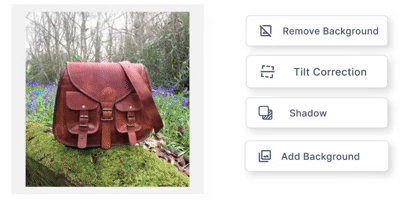
So, to help you unburden from this tedious task and automate the photography process for visual listings, Spyne AI brings you state-of-the-art AI tools to produce high-converting product images.
Spyne’s cutting-edge tech leverages its vast expertise and training on millions of images to revolutionize the editing process of your product images. With Spyne’s API, you can effortlessly enhance and optimize your product visuals, ensuring they shine in the best possible light. Thus, from flawless retouching to consistent editing, Spyne’s image editing services deliver top-notch results tailored to eCommerce platforms.
What does Spyne AI offer?
1. Image edit within 5 seconds while ensuring 99 percent accuracy across SKUs.
2. Processes 10,000+ images daily and enabling you 3X faster cataloging.
3. Saves over 50 percent of your costs by producing marketplace-ready images in seconds, therefore, decreasing the cost of producing images.
4. Helps with one-click image background alteration with hundreds of customizable background templates
5. Publish to various marketplaces in just one click while ensuring it fits the marketplace guidelines.
Does this intrigue you, and do you want to learn more about eCommerce visual merchandising for your online business? So, what are you waiting for? Reach out to us today!
Conclusion
Effective visual merchandising is the key to retail success, shaping customer experiences and driving sales. Whether in-store or online, the strategic use of displays, color, lighting, and technology enhances the overall journey. In the digital realm, personalized approaches, compelling visuals, and seamless navigation are crucial for e-commerce success. By following best practices, utilizing tools like Spyne AI, and consistently optimizing strategies, businesses can create engaging shopping experiences that resonate with customers, boost sales, and establish a strong brand presence. Mastering merchandising is the pathway to leaving a lasting impression and achieving success in the dynamic world of retail.

